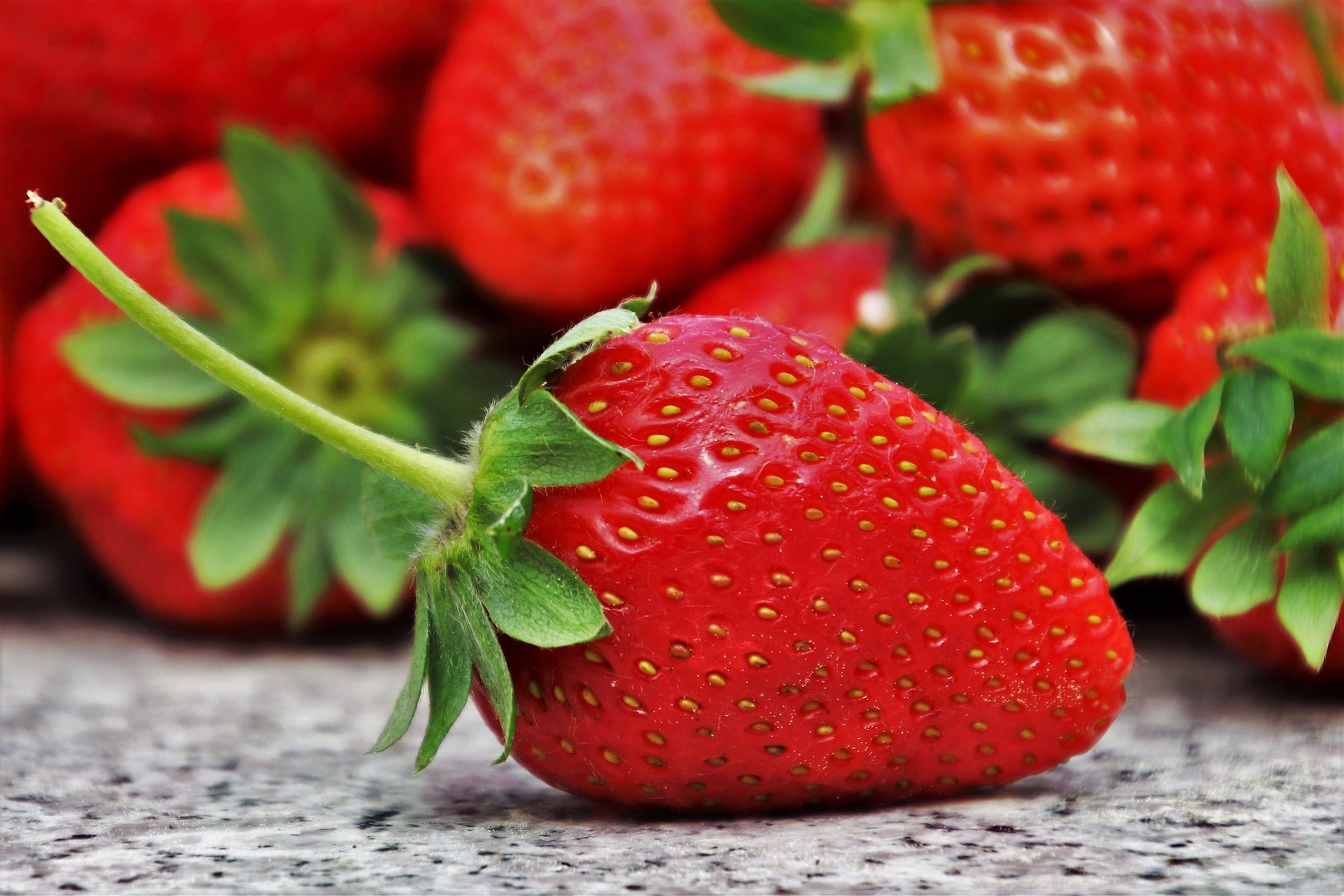About Strawberries
Strawberries are truly the jewels of summer - and they’re perfect for beginning gardeners! If you’ve never had a strawberry picked fresh, you’re in for a treat.
There are two main types of strawberries, June-bearing and ever-bearing. June-bearing types tend to produce a large, concentrated crop over a short period of time. Typically, yes, in June but the harvest can extend until July. This is great for gardeners who love to can their harvests to enjoy strawberries through the winter. Ever-bearing strawberries produce fruit throughout the growing season but have two larger, concentrated yields in early summer and again in fall. You can certainly preserve these varieties as well but they’re also great for a regular midsummer treat and tend to produce smaller amounts overall.
Recommended Strawberry Varieties

Seascape Strawberries
This ever-bearing variety was developed at the University of California and produces a high yield of firm, large, flavorful berries. These well-shaped berries have a superb flavor and bear fruit over a long season. They’re one of the most productive and disease resistant varieties out there! Their shallow roots make them ideal for containers.

Jewel Strawberries
This June-bearing strawberry is an excellent performer, doing well over a wide range of growing conditions. This variety is recommended for commercial growers and home gardeners alike because of its sweet and uniform fruits. These large berries have amazing quality and flavor.

Ozark Beauty Strawberries
The Ozark Beauty was developed in Arkansas and is well suited for cooler regions of the North and higher elevations in the South. Ozark Beauty strawberries are considered to be one of the best ever-bearing varieties. They are vigorous and extremely prolific producers. They produce fairly large berries that are deep red and honey sweet.

Sparkle Strawberries
This June-bearing heirloom is thought by many to be the best strawberry for jam and freezing. You’ll be rewarded with a nice crop of flavorful, high quality strawberries year after year if you manage your bed and don’t allow it to become too cramped. It’s a great beginner variety as well.
How Many Strawberries per Plant?
Strawberry plants spread… a lot. They produce runners that root and grow into new plants! Typically, strawberries will be planted 18 inches apart in rows that are 3 feet apart. This leaves plenty of room for runners. You’ll want to loosely calculate how many plants you’ll need based on your growing space but the great part is if you don’t order enough, they’ll fill in the bed in no time!
Planting Strawberries
Planting strawberries is easy, fun, and will save you a few bucks at the grocery store. While anyone can do it with success, there are just a few things you may want to take into consideration.
Where to Plant Strawberries
Strawberries require full sun - this means six to ten hours per day. So you’ll want to choose your planting site (or container location) with that in mind. Well-draining soil helps to keep the crowns from rotting, so a raised bed is a great location for drainage as well as to keep the strawberries from taking over your garden. Well-composted soil will work great too, as long as your in-ground bed goes pretty deep - about twelve inches.
When to Plant Strawberries
Strawberries are planted early in the season, as soon as the ground is workable in the spring. This is typically six to eight weeks before your last frost.
How to Plant Strawberries
The bare root strawberries you order from us are dormant plants. This just means that you’ll have to take the extra step of waking them up! We do this by soaking the bare roots in a bowl or bucket of water, only soaking the roots and keeping the crowns from being submerged. Soaking your plants for about 20 minutes before planting helps to bring the strawberries out of dormancy.
Dig your planting holes as deep as the roots are long and twice as wide. Gently spread out the roots in the hole and fill in with soil around the roots, keeping the crown of the plant at soil level. It is especially important not to bury the crown because this is where the plant will grow from. Burying it will take a toll on the fruit and runner production. Space the plants 18 inches apart in rows that are 3 feet apart.
Water well after planting and lay a two-inch layer of mulch around each plant to conserve moisture. Throughout the season, make sure strawberries get one to two inches of water per week. Bare root plants should begin leafing out in early summer. Take care to keep the bed weeded without overly disturbing the crown of the plant.
Growing Strawberries
Strawberries are a perennial crop in many growing zones. They can produce for years on end if well cared for and maintained.
How Long Does It Take to Grow Strawberries?
Strawberries can produce fruit in the first year (though not at their fullest potential). That being said, to create a long standing and reliable perennial crop you may have to sacrifice some of that first season's harvest.
Right after planting, pinch off any flower buds that appear in the first few weeks. This will help the plant produce leaves and roots so that when the flowers are pollinated and begin to produce fruit, there is enough energy and strength in the plant to develop the gorgeous fruit you’re expecting. If you’re growing strawberries as a perennial we recommend pinching off most, if not all, of the flowers in the first year. This will help to get the plants well and established and encourage it to put its energy towards producing runners so that next year’s crop will be truly abundant.
Your original strawberry plants will produce up to four or five years, though yield can reduce dramatically after about three. But the beauty of this is that as your plants produce runners, you’re getting brand new plants every year! In order to maintain this production, and keep your plants healthy, pull out your oldest plants every two to three years.
Maintaining your Strawberry Crop
While strawberries are very low maintenance, there are some steps you can take to get the most out of your beautiful plants! Consider an annual application of a balanced fertilizer (a 5-5-5 or 10-10-10 will do just fine) as you begin to see leaf growth each year.
Keeping your strawberry beds weeded is integral to the long term health of your plants. Having a constant two-inch layer of mulch can significantly help reduce the amount of labor you have to do weeding your beds. Weeding can also disturb or damage roots and crowns so mulch helps avoid that as well.
During the growing season, ensure that your plants get at least an inch of water per week between rain or your garden hose.
Preventing Pests & Diseases
If you have an issue with slugs in your garden, consider using a plastic mulch rather than organic. Organic mulches can often encourage slugs in the garden and in terms of strawberries, it can quickly become a losing battle.
During the summer there are several fungal diseases that can cause dark spots to form on the leaves. While this can become a yearly issue, unless severe, it usually doesn’t harm the fruits. Keeping your strawberries bed thinned can help significantly with stopping the spread of fungal diseases. Ground level watering (rather than overhead) can also help by keeping the foliage dry.
Birds are by far the worst pests of strawberries. They find the fruit as delicious as we do! If you find this is a problem year after year, use some lightweight bird netting to deter them as the fruits are ripening.
How to Grow Sweeter Strawberries
Strawberries will be sweeter when grown in compost and nutrient dense, well-draining soils. Too much water can also water down the flavor of the fruit, similarly to watermelons.
How to Grow Larger Strawberries
The best way to grow large strawberries is to limit the number of strawberries you ask your plant to produce. However many flowers bloom, pinch off half of them. This will force that energy to be divided amongst the to-be fruits that will remain. Removing runners can also help increase the size of your berries.
How to Harvest Strawberries
Strawberry plants will be ready to harvest four to six weeks after flowering. Harvest only the reddest, ripest berries and be sure to check back every two to three days - to take advantage as they continue to ripen and produce. Use pruners to snip off the stem above the fruit. Pulling the fruit can cause damage to the plant.
How to Store Strawberries
Strawberries can be stored fresh and unwashed in the refrigerator for three to five days. Wet berries can spoil quickly and they should only be washed right before eating. They can also be stored whole and frozen quite easily.
Canning cooked strawberries (try a jam or pie filling) can also be a great way to enjoy these sweet jewels of summer all year long!
Strawberries are an easy, doable, and rewarding crop for gardeners of any size and experience level.

|
Article Written by: Hannah Gibbons |
|
About the Author: Hannah Gibbons, an employee at Sow True Seed since 2020, has nearly a decade of experience in the agricultural industry. Their passion for environmental education and regenerative agriculture has been the cornerstone of their work, aimed at making gardening accessible to all. |



